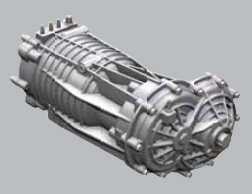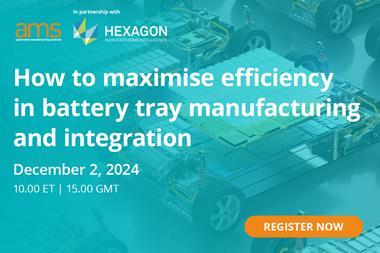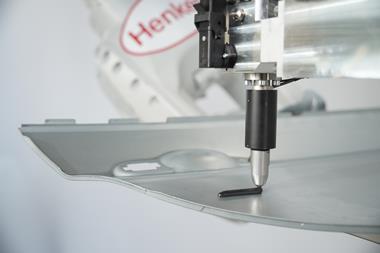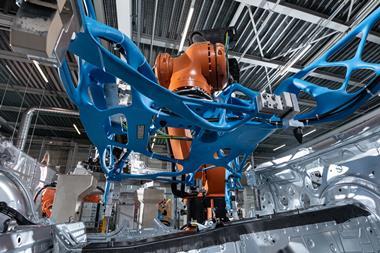Bodywork and chassis are not the only parts of the car that make use of aluminium. The powertrain has been revolutionised over the past 10 years or so. Before then, engine blocks and gearbox casings were either steel or iron. Not so any more. “We wouldn’t think of using cast iron in crankcases for performance cars, now,” says Patrick Ward, senior metallurgist at Bentley.
GKN Structures, which specialises in the design, manufacture and supply of pressed steel, structural assemblies, modules and chassis aluminium, is transferring the knowledge it has gained from its experience of military applications to agricultural and off-road vehicles. GKN says that the defence sector demands a markedly more customised approach than the mainstream auto industry. Military vehicles encounter challenging terrain as a matter of routine and therefore require more advanced independent suspension and driveline solutions than conventional vehicles.
GKN has used the Squeezeform process widely over 15 years, in supplying the needs of the military sector. It is used to produce wheels for the Warrior Infantry Fighting Vehicle, as well as a number of new tracked vehicles. Squeezeforming uses closely controlled cooling and solidification of molten aluminium under pressure, which is claimed to give the metal excellent mechanical properties. It is a direct casting process that produces high strength, low weight components, with low porosity and fine microstructures and is suitable for heat treatment and for weldable alloys. The process uses a die that is fed with a metered amount of aluminium alloy. A punch is then advanced until the liquid metal is pressurised; the press is held at a preset pressure for a finite time until the component has solidified.
The company is now developing the process for applications in, initially, the agricultural sector. The process enables the production of lightweight, high strength aluminium components and accommodates cast-in inserts using other materials, giving locally-improved wear resistance. The process also helps in the design of components for reduced envelope sizes. GKN says that the main benefit of using this technique is that components produced are 35% lighter than their standard counterparts. The wheels are also claimed to increased endurance – four times that of a typical traditional forged steel AFV wheel, leading to competitive total lifetime costs.

Altair’s senior director of global automotive and off-highway vehicles Tony Norton concurs. “A few years ago it was common to see steel blocks; now, it is rare,” he says. “Most blocks are now aluminium. We are seeing, in high-end manufacturers, a move to more powertrain efficiency. Consumers in the USA want more efficient vehicles and OEMs are seeking more efficiency within the internal combustion engine, as well as in novel powertrains. If weight in powertrains is reduced, that helps to achieve the objective.”
Strength and resilience
Well-known transmission specialists ZF began using aluminium in 1965 in the housings and control units of automatic gearboxes, although some manual boxes had aluminium housings from the mid-1950s. The company also makes chassis components; since the beginning of the 1980s for die-cast parts; since the mid-80s for extruded sections and deep-drawn parts; and for more than 20 years for control arms. In all these examples, aluminium replaced steel as the material of choice, with weight reduction and integrated surface protection regarded as the most important advantages. Whatever the application, strength and resilience are important considerations in critical applications. “The resilience of a product depends heavily on how much you know about this product and its application and of course it also depends on the materials and technologies used during the design phase and in production,” says ZF spokesman Robert Buchmaier. Treatment depends on the required properties. “Stress-relief annealing, for example, may help to retain tolerances for distortion-critical castings. Heat treatment of high-strength aluminium alloys may be adapted in order to achieve sufficient ductility, maximum overload, or fatigue strength”, he explains.
“Surface treatment does not only affect corrosion behaviour; in many cases it also has an impact on the structural durability of the part. For some applications, a good wear resistance is required. In order to improve the wear resistance, some parts – mainly wrought aluminium alloys – could be hardanodised.” The company is not ‘married’ to aluminium; it constantly considers other materials – including plastics – in the quest for weight, packaging, performance and cost advantages.
Material substitution
“The role of aluminium will increase as weight reduction is a very important factor in reducing CO2 emissions,” says Buchmaier, pointing out that it has its own material characteristics which need to be respected for product design, during product verification, and for the production concept.
 One potential risk is in material substitution, where the same rules that apply to steel could be used for design, verification, and production. “One of the key advantages of aluminium is its lower density compared to steel – but at the same time, the mechanical properties are lower”, he explains. It is easy to focus on one advantage, particularly weight reduction, but all aspects have to be considered. “With regard to the stiffness (Young’s modulus) however, steel might even have a slight advantage in weight. For many applications, you cannot use this advantage as you very often have to add material for production purposes or for the interface to other parts for which the stiffness is not required. This often overcompensates the ‘stiffness advantage’ of steel. In these cases, hybrid or combined technologies offer potential for further weight reductions.” According to ZF then, it can be difficult or challenging to use aluminium if there is a high specific load, a need for high wear resistance, very limited package sizes, or a need for high stiffness.
One potential risk is in material substitution, where the same rules that apply to steel could be used for design, verification, and production. “One of the key advantages of aluminium is its lower density compared to steel – but at the same time, the mechanical properties are lower”, he explains. It is easy to focus on one advantage, particularly weight reduction, but all aspects have to be considered. “With regard to the stiffness (Young’s modulus) however, steel might even have a slight advantage in weight. For many applications, you cannot use this advantage as you very often have to add material for production purposes or for the interface to other parts for which the stiffness is not required. This often overcompensates the ‘stiffness advantage’ of steel. In these cases, hybrid or combined technologies offer potential for further weight reductions.” According to ZF then, it can be difficult or challenging to use aluminium if there is a high specific load, a need for high wear resistance, very limited package sizes, or a need for high stiffness.
“Transmissions have roller bearings, shafts, or gears and here it will be difficult to replace steel. However, it largely depends on the application and the product design”, Buchmaier concludes





































